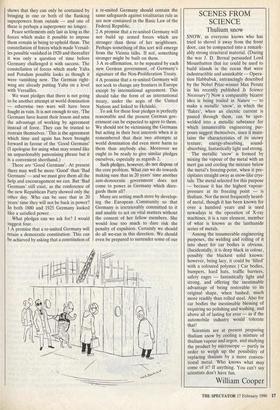SCENES FROM SCIENCE
Thulium snow
SNOW, as everyone knows who has tried to shovel it away from the front door, can be compacted into a remark- ably strong structural material. (During the war J. D. Bernal persuaded Lord Mountbatten that ice could be used to build islands in the ocean that were indestructible and unsinkable — Opera- tion Habbabuk, entrancingly described by the Nobel Prize-winner Max Perutz in his recently published Is Science Necessary?) Now a comparably bizarre idea is being trailed in Nature — to make a metallic 'snow', in which the 'flakes', when an electric current is passed through them, can be spot- welded into a metallic substance for which innumerable engineering pur- poses suggest themselves, since it main- tains the characteristics of its snowy texture; energy-absorbing, sound- absorbing, fantastically light and strong.
The metallic 'snow' is formed by mixing the vapour of the metal with an inert gas and cooling the mixture below the metal's freezing-point, when it pre- cipitates straight away as snow-like crys- tals. The metal selected for this purpose — because it has the highest vapour- pressure at its freezing point — is thulium. Not the most frequently heard- of metal, though it has been known for over a hundred years and is used nowadays in the operation of X-ray machines, it is a rare element, member of what is known as the lanthanide series of metals.
Among the innumerable engineering purposes, the welding and rolling of it into sheet for car bodies is obvious. (Incidentally, it is deep black in colour, possibly the blackest solid known: however, being lacy, it could be 'filled' with a coloured 'polymer.) Car bodies, bumpers, hard hats, traffic barriers, safety cages — fantastically light and strong, and offering the inestimable advantage of being restorable to its original shape, when bashed, much more readily than rolled steel. Also for car bodies the inestimable blessing of requiring no polishing and washing, and above all of lasting for ever — as if the automobile industry would tolerate that!
Scientists are at present preparing thulium snow by cooling a mixture of thulium vapour and argon, and studying the product by microscope — partly in order to weigh up the possibility of replacing thulium by a more conven- tional metal. Who knows what may come of it? If anything. You can't say scientists don't have fun.
William Cooper


















































 Previous page
Previous page